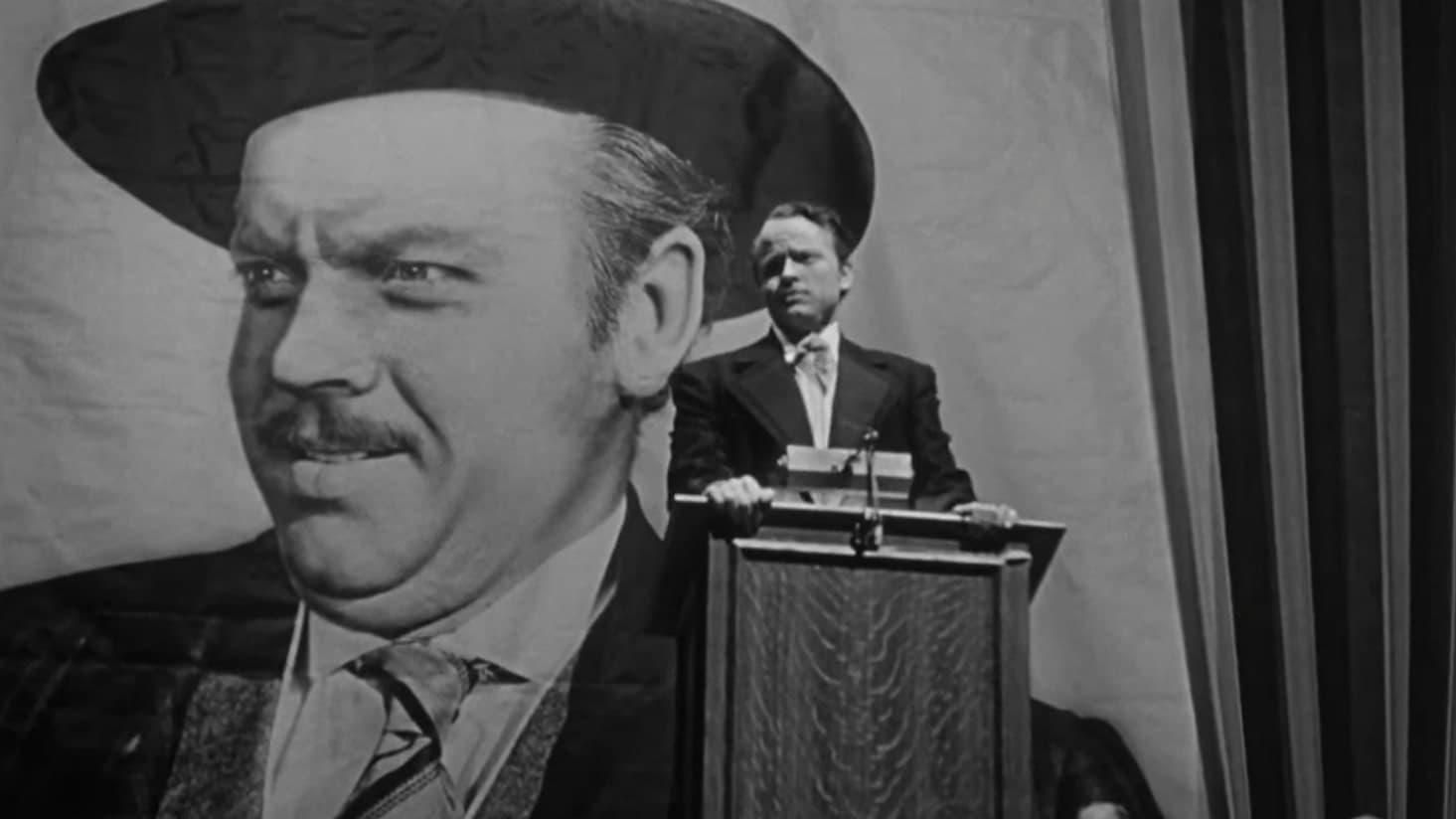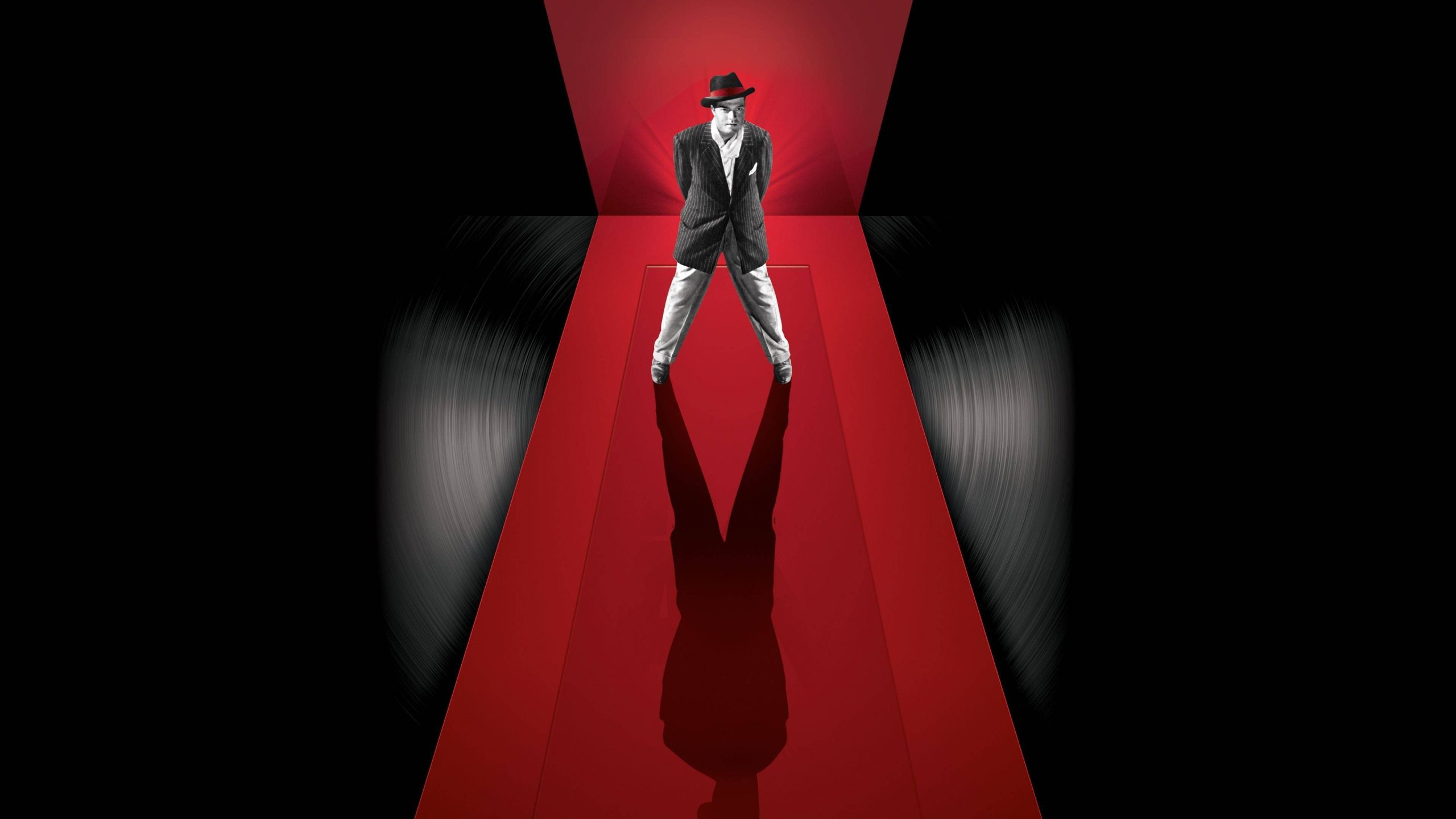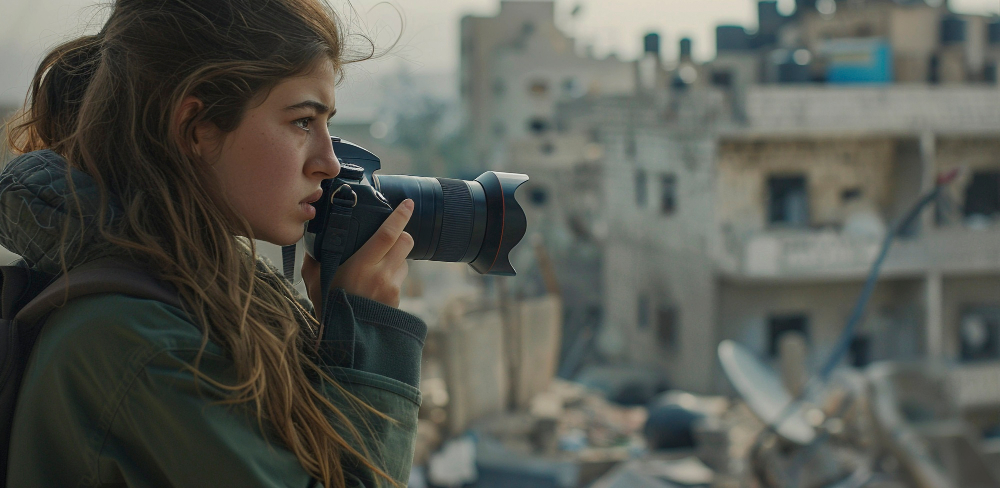Citizen Kane revolutionized cinematography, largely due to Gregg Toland’s groundbreaking work. Its most famous innovation was deep focus, keeping foreground, middle ground, and background sharp simultaneously, demanding specialized lenses and lighting.
This technique allowed Orson Welles to convey complex relationships and power dynamics within a single, expansive frame, reducing the need for cuts and mimicking human vision.
Other revolutionary techniques included low-angle shots revealing ceilings (a rarity then), dramatic chiaroscuro lighting for stark contrasts, and inventive use of matte paintings and miniatures to create Kane’s sprawling Xanadu.
The film’s dynamic compositions, stark shadows, and fluid camera movements profoundly influenced subsequent filmmakers, establishing a visual language that pushed cinematic boundaries and remains studied for its artistic daring and technical mastery. Its legacy lies in proving that cinematography is not just about capturing images, but an integral storytelling tool.
The cinematography in Citizen Kane.
Citizen Kane is known for its innovative use of cinematography techniques, particularly the use of deep focus, which refers to having everything in the frame, even the background, in focus at the same time, as opposed to having only the people and things in the foreground in focus.
This technique requires the cinematographer to combine lighting, composition, and type of camera lens to produce the desired effect.
Gregg Toland, the cinematographer chosen by Orson Welles for Citizen Kane, had used the technique in an earlier film he had worked on, The Long Voyage Home. Toland’s immense contribution to Citizen Kane lent the film its visual identity associated with German Expressionism, and many scholars attribute the visual grandeur of Kane to Toland’s virtuosity.
The cinematography and acting technique combined so perfectly that the total control Welles was given over casting was justified. Citizen Kane was nominated for Best Cinematography at the Academy Awards, which was no surprise given the film’s innovative use of lighting and shadow.
Toland’s work on Citizen Kane, with innovations including deep focus, is iconic and has influenced many filmmakers since. The camera movements established by the groundbreaking crane shots would go on to become a staple of Hollywood filmmaking.
How did the use of deep focus in Citizen Kane influence other films?
Citizen Kane’s use of deep focus has had a significant impact on the film industry, influencing many filmmakers since its release.
The deep focus technique, which requires the cinematographer to combine lighting, composition, and type of camera lens to produce the desired effect, allows subjects close and far away from the camera to remain in focus and is achieved by using a wide-angle lens and a smaller aperture.
The use of deep focus in Citizen Kane opened up cinematic space and helped convey spatial, causal, and psychological relationships within the frame. The camera movements established by the groundbreaking crane shots would go on to become a staple of Hollywood filmmaking. The film’s innovative use of lighting and shadow also earned it a nomination for Best Cinematography at the Academy Awards.
Many filmmakers have since used deep focus to create a sense of depth and realism in their films. For example, Martin Scorsese used deep focus in his film Goodfellas to create a sense of immersion in the world of the characters. The technique has also been used in films such as The Godfather, Schindler’s List, and The Shawshank Redemption1.
What other cinematic techniques were used in Citizen Kane besides deep focus?
Citizen Kane is known for its innovative use of cinematography techniques beyond deep focus. Gregg Toland, the cinematographer chosen by Orson Welles for Citizen Kane, had used the deep focus technique in an earlier film he had worked on, The Long Voyage Home. Other cinematic techniques used in Citizen Kane include:
- Low-angle shots: These shots were used to create a sense of power and dominance in the characters.
- High-angle shots: These shots were used to create a sense of vulnerability and powerlessness in the characters.
- Wide-angle lenses: These lenses were used to create a sense of depth and space in the frame.
- Overlapping dialogue: This technique was used to create a sense of realism in the dialogue and to convey the chaotic nature of the characters’ lives.
- Non-linear narrative: Citizen Kane challenged traditional narrative elements of classic Hollywood cinema by using a non-linear narrative structure.
These techniques, combined with the innovative use of deep focus, helped create the visual identity associated with German Expressionism that Citizen Kane is known for1.
Examples of films that were influenced by Citizen Kane’s use of deep focus.
Citizen Kane’s use of deep focus has had a significant impact on the film industry, influencing many filmmakers since its release. Deep focus allows subjects close and far away from the camera to remain in focus and is achieved by using a wide-angle lens and a smaller aperture.
Many filmmakers have since used deep focus to create a sense of depth and realism in their films. Some examples of films that were influenced by Citizen Kane’s use of deep focus include:
- Goodfellas (1990) directed by Martin Scorsese
- The Godfather (1972) directed by Francis Ford Coppola
- Schindler’s List (1993) directed by Steven Spielberg
- The Shawshank Redemption (1994) directed by Frank Darabont1
How did Citizen Kane’s use of long-take cinematography contribute to its realism?
One of the most widely discussed theories surrounding Citizen Kane is that of cinematic realism. At the center of the film’s realism is deep-focus and long-take cinematography. According to Gregg Toland, the cinematographer chosen by Orson Welles for Citizen Kane, the deep-focus and long-take styles were developed from Welles’ insistence on realism.
Welles wanted the audience to be unaware of the cinematic apparatus by creating scenes that would flow together imperceptibly without the need for inter-cutting. The use of long-take cinematography in Citizen Kane contributed to its realism by creating a sense of continuity and immersion in the world of the film.
By using long takes, the film was able to capture the characters’ movements and interactions in real-time, giving the audience a sense of being present in the scene. This technique also allowed for the use of deep focus, which further enhanced the film’s realism by allowing subjects close and far away from the camera to remain in focus.
What is mise-en-scene and how was it used in Citizen Kane?
Mise-en-scene refers to the arrangement of visual elements within a frame, including lighting, set design, costumes, and the movement and positioning of characters. Citizen Kane is known for its innovative use of mise-en-scene, which helped create the visual identity associated with German Expressionism that the film is known for.
Some examples of how mise-en-scene was used in Citizen Kane include:
- Low-angle shots: These shots were used to create a sense of power and dominance in the characters.
- High-angle shots: These shots were used to create a sense of vulnerability and powerlessness in the characters.
- Wide-angle lenses: These lenses were used to create a sense of depth and space in the frame.
- Overlapping dialogue: This technique was used to create a sense of realism in the dialogue and to convey the chaotic nature of the characters’ lives.
- Non-linear narrative: Citizen Kane challenged traditional narrative elements of classic Hollywood cinema by using a non-linear narrative structure.
The use of mise-en-scene in Citizen Kane, combined with the innovative use of deep focus and long-take cinematography, helped create a film that was groundbreaking in its visual style and storytelling techniques.
How did Citizen Kane’s use of mise-en-scene contribute to its storytelling?
Citizen Kane is known for its innovative use of mise-en-scene, which helped create the visual identity associated with German Expressionism that the film is known for. Mise-en-scene refers to the arrangement of visual elements within a frame, including lighting, set design, costumes, and the movement and positioning of characters.
The use of mise-en-scene in Citizen Kane contributed to its storytelling by creating a visual language that conveyed the characters’ emotions and motivations. For example, low-angle shots were used to create a sense of power and dominance in the characters, while high-angle shots were used to create a sense of vulnerability and powerlessness.
The use of wide-angle lenses created a sense of depth and space in the frame while overlapping dialogue created a sense of realism in the dialogue and conveyed the chaotic nature of the characters’ lives.
Citizen Kane’s use of mise-en-scene, combined with the innovative use of deep focus and long-take cinematography, helped create a film that was groundbreaking in its visual style and storytelling techniques1.
What other films have used long-take cinematography to achieve realism?
Long-take cinematography has been used in many films to achieve a sense of realism and immersion in the world of the film. Some examples of films that have used long-take cinematography include:
- Children of Men (2006) directed by Alfonso Cuarón.
- Birdman (2014) directed by Alejandro González Iñárritu.
- 1917 (2019) directed by Sam Mendes.
- Rope (1948) directed by Alfred Hitchcock.
These films, like Citizen Kane, use long takes to capture the characters’ movements and interactions in real-time, giving the audience a sense of being present in the scene.
How has the use of deep focus evolved in modern cinema?
The use of deep focus has evolved in modern cinema with the advancement of technology and the use of digital cameras. While deep focus was achieved in Citizen Kane by using a wide-angle lens and a smaller aperture, modern filmmakers can achieve the same effect using digital cameras and post-production techniques.
In addition, modern filmmakers have expanded on the use of deep focus by combining it with other techniques, such as handheld camera work and rapid editing, to create a sense of immediacy and realism.
For example, the film Children of Men uses deep focus in combination with handheld camera work to create a sense of chaos and urgency in the film’s action sequences. Overall, the use of deep focus continues to be an important technique in modern cinema, allowing filmmakers to create a sense of depth and realism in their films.
What is the significance of Citizen Kane’s use of deep focus in cinematography?
Citizen Kane’s use of deep focus in cinematography is significant because it allowed for a greater sense of depth and realism in the film. Deep focus refers to having everything in the frame, even the background, in focus at the same time, as opposed to having only the people and things in the foreground in focus.
This technique requires the cinematographer to combine lighting, composition, and type of camera lens to produce the desired effect.Citizen Kane’s use of deep focus allowed for a greater sense of immersion in the world of the film, as the audience was able to see everything in the frame in sharp detail1.
This technique also allowed for more complex compositions, as the cinematographer could place multiple subjects at different depths in the frame and have them all in focus. Citizen Kane’s use of deep focus was groundbreaking at the time and has influenced many filmmakers since.
How did Citizen Kane’s use of deep focus contribute to the film’s visual identity?
Citizen Kane’s use of deep focus in cinematography was a key element in creating the film’s visual identity. The deep focus technique, which allows subjects close and far away from the camera to remain in focus, creates a sense of depth and realism in the frame.
Citizen Kane’s use of deep focus allowed for complex compositions and a greater sense of immersion in the world of the film. This technique, combined with other cinematic techniques such as low-angle and high-angle shots, wide-angle lenses, and overlapping dialogue, helped create the visual identity associated with German Expressionism that Citizen Kane is known for.
Overall, Citizen Kane’s use of deep focus was a significant contribution to the film’s visual style and has influenced many filmmakers since its release.
What other cinematic techniques were used in Citizen Kane besides deep focus?
Citizen Kane is known for its innovative use of cinematography techniques beyond deep focus. Other cinematic techniques used in Citizen Kane include:
- Low-angle shots: These shots were used to create a sense of power and dominance in the characters.
- High-angle shots: These shots were used to create a sense of vulnerability and powerlessness in the characters.
- Wide-angle lenses: These lenses were used to create a sense of depth and space in the frame.
- Overlapping dialogue: This technique was used to create a sense of realism in the dialogue and to convey the chaotic nature of the characters’ lives.
- Non-linear narrative: Citizen Kane challenged traditional narrative elements of classic Hollywood cinema by using a non-linear narrative structure.
- Mise-en-scene: The arrangement of visual elements within a frame, including lighting, set design, costumes, and the movement and positioning of characters, was used to convey the characters’ emotions and motivations.
These techniques, combined with the innovative use of deep focus, helped create the visual identity associated with German Expressionism that Citizen Kane is known for.
How did Citizen Kane’s use of long-take cinematography contribute to its realism?
Citizen Kane’s use of long-take cinematography contributed to its realism by creating a sense of continuity and immersion in the world of the film. Long takes to allow the camera to capture the characters’ movements and interactions in real-time, giving the audience a sense of being present in the scene.
Citizen Kane’s use of long-take cinematography was also closely tied to its use of deep focus, as both techniques allowed for a greater sense of depth and realism in the frame. The use of long takes also allowed for the camera to move through the space of the film in a more natural and fluid way, contributing to the film’s immersive storytelling1.
Overall, Citizen Kane’s use of long-take cinematography was a significant contribution to the film’s realism and has influenced many filmmakers since its release.
What is the impact of Citizen Kane’s innovative use of lighting and shadow on film noir?
Citizen Kane’s innovative use of lighting and shadow had a significant impact on the development of film noir. Film noir is a genre of film characterized by its use of low-key lighting, shadowy visuals, and a sense of moral ambiguity.
Citizen Kane’s use of lighting and shadow helped create the visual identity associated with film noir, particularly in its use of chiaroscuro lighting, which emphasizes the contrast between light and dark.
The film’s use of deep focus also allowed for more complex lighting setups, as the cinematographer could light multiple subjects at different depths in the frame. Overall, Citizen Kane’s innovative use of lighting and shadow helped establish the visual language of film noir and has influenced many filmmakers since its release.
How did Citizen Kane’s use of overlapping dialogue contribute to its realism?
Citizen Kane’s use of overlapping dialogue contributed to its realism by creating a sense of chaos and naturalism in the dialogue. Overlapping dialogue refers to the technique of having characters speak at the same time, creating a sense of realism in the conversation.
Citizen Kane’s use of overlapping dialogue was closely tied to its use of long-take cinematography, as both techniques allowed for a greater sense of continuity and immersion in the world of the film.
The use of overlapping dialogue also conveyed the chaotic nature of the characters’ lives and helped create a sense of realism in the film’s dialogue. Overall, Citizen Kane’s use of overlapping dialogue was a significant contribution to the film’s realism and has influenced many filmmakers since its release.
What is the significance of Citizen Kane’s non-linear narrative structure?
Citizen Kane’s non-linear narrative structure was significant because it challenged traditional narrative elements of classic Hollywood cinema. The film tells the story of the life of Charles Foster Kane through a series of flashbacks and interviews, with no clear chronological order.
Citizen Kane’s non-linear narrative structure allowed for a more complex and layered storytelling approach, as the audience was forced to piece together the story of Kane’s life through multiple perspectives and timelines.
This technique also allowed for a greater sense of ambiguity and mystery in the film’s narrative, as the audience was never quite sure what was going to happen next. Overall, Citizen Kane’s non-linear narrative structure was a significant contribution to the film’s storytelling and has influenced many filmmakers since its release.
How did Citizen Kane’s use of low-angle and high-angle shots contribute to its storytelling?
Citizen Kane’s use of low-angle and high-angle shots contributed to its storytelling by creating a sense of power dynamics between the characters. Low-angle shots were used to create a sense of power and dominance in the characters, while high-angle shots were used to create a sense of vulnerability and powerlessness.
Citizen Kane’s use of low-angle and high-angle shots helped convey the emotional and psychological states of the characters, as well as their relationships with each other.
This technique also allowed for a more complex and nuanced portrayal of the characters, as the audience was able to see them from multiple perspectives. Overall, Citizen Kane’s use of low-angle and high-angle shots was a significant contribution to the film’s storytelling and has influenced many filmmakers since its release.
What is the significance of Citizen Kane’s use of wide-angle lenses in cinematography?
Citizen Kane’s use of wide-angle lenses in cinematography was significant because it allowed for a greater sense of depth and space in the frame. Wide-angle lenses have a shorter focal length than normal lenses, which allows for a wider field of view and a greater sense of depth in the frame.
Citizen Kane’s use of wide-angle lenses allowed for more complex compositions and a greater sense of immersion in the world of the film. This technique also allowed for a more dynamic and fluid camera movement, as the cinematographer could move the camera through the space of the film in a more natural and fluid way.
Overall, Citizen Kane’s use of wide-angle lenses was a significant contribution to the film’s visual style and has influenced many filmmakers since its release.
How did Citizen Kane’s use of mise-en-scene contribute to its storytelling?
Citizen Kane’s use of mise-en-scene contributed to its storytelling by creating a visual language that conveyed the characters’ emotions and motivations. Mise-en-scene refers to the arrangement of visual elements within a frame, including lighting, set design, costumes, and the movement and positioning of characters.
Citizen Kane’s use of mise-en-scene allowed for a more nuanced and complex portrayal of the characters, as the audience was able to see their emotions and motivations through their physical surroundings.
This technique also allowed for a greater sense of immersion in the world of the film, as the audience was able to see the characters’ physical surroundings in detail. Overall, Citizen Kane’s use of mise-en-scene was a significant contribution to the film’s storytelling and has influenced many filmmakers since its release.
What is the impact of Citizen Kane’s visual style on modern filmmaking?
Citizen Kane’s visual style has had a significant impact on modern filmmaking, influencing many filmmakers since its release. The film’s innovative use of deep focus, long-take cinematography, and mise-en-scene helped create a visual identity associated with German Expressionism that Citizen Kane is known for.
Citizen Kane’s visual style has influenced many filmmakers, particularly in the areas of cinematography and storytelling. The film’s use of deep focus and long-take cinematography has been emulated in many films since, while its use of mise-en-scene has influenced the way filmmakers use visual elements to convey meaning1.
Overall, Citizen Kane’s visual style has had a lasting impact on modern filmmaking, helping to establish a visual language that is still influential today.
How did Citizen Kane’s use of deep focus influence other films?
Citizen Kane’s use of deep focus in cinematography has had a significant influence on other films. Deep focus allows subjects close and far away from the camera to remain in focus, creating a sense of depth and realism in the frame.
Many filmmakers have since used deep focus to create a sense of immersion in the world of their films. Some examples of films that have been influenced by Citizen Kane’s use of deep focus include Goodfellas (1990), The Godfather (1972), Schindler’s List (1993), and The Shawshank Redemption (1994). Overall, Citizen Kane’s use of deep focus has had a lasting impact on the film industry, influencing many filmmakers since its release.
What other films have used deep focus to achieve a sense of depth and realism?
Many films have used deep focus to achieve a sense of depth and realism in the frame. Some examples of films that have used deep focus include:
- Goodfellas (1990) directed by Martin Scorsese.
- The Godfather (1972) directed by Francis Ford Coppola.
- Schindler’s List (1993) directed by Steven Spielberg.
- The Shawshank Redemption (1994) directed by Frank Darabont.
- Roma (2018) directed by Alfonso Cuarón.
- Dunkirk (2017) directed by Christopher Nolan.
These films, like Citizen Kane, use deep focus to create a sense of immersion in the world of the film and a greater sense of depth in the frame.
How has the use of deep focus evolved in modern cinema?
The use of deep focus has evolved in modern cinema with the advancement of technology and the use of digital cameras. While the deep focus was achieved in Citizen Kane by using a wide-angle lens and a smaller aperture, modern filmmakers can achieve the same effect using digital cameras and post-production techniques.
In addition, modern filmmakers have expanded on the use of deep focus by combining it with other techniques, such as handheld camera work and rapid editing, to create a sense of immediacy and realism.
Overall, the use of deep focus continues to be an important technique in modern cinema, allowing filmmakers to create a sense of depth and realism in their films.
What is the impact of Citizen Kane’s use of long-take cinematography on modern filmmaking?
Citizen Kane’s use of long-take cinematography has had a significant impact on modern filmmaking, influencing many filmmakers since its release. Long takes to allow the camera to capture the characters’ movements and interactions in real-time, giving the audience a sense of being present in the scene.
Citizen Kane’s use of long-take cinematography was also closely tied to its use of deep focus, as both techniques allowed for a greater sense of depth and realism in the frame .
The use of long takes also allowed for the camera to move through the space of the film in a more natural and fluid way, contributing to the film’s immersive storytelling.
Overall, Citizen Kane’s use of long-take cinematography has had a lasting impact on modern filmmaking, influencing many filmmakers since its release.
What other films have used long-take cinematography to achieve a sense of realism?
Many films have used long-take cinematography to achieve a sense of realism and immersion in the world of the film. Some examples of films that have used long-take cinematography include:
- Children of Men (2006) directed by Alfonso Cuarón.
- Birdman (2014) directed by Alejandro González Iñárritu.
- 1917 (2019) directed by Sam Mendes.
- Rope (1948) directed by Alfred Hitchcock.
These films, like Citizen Kane, use long takes to capture the characters’ movements and interactions in real-time, giving the audience a sense of being present in the scene.
How did Citizen Kane’s use of deep focus and long-take cinematography contribute to its realism?
Citizen Kane’s use of deep focus and long-take cinematography contributed to its realism by creating a sense of continuity and immersion in the world of the film. Deep focus allowed for a greater sense of depth in the frame, while long takes allowed the camera to capture the characters’ movements and interactions in real-time.
Citizen Kane’s use of deep focus and long-take cinematography was also closely tied to its use of mise-en-scene, as all three techniques worked together to create a visual language that conveyed the characters’ emotions and motivations1.
Overall, Citizen Kane’s use of deep focus and long-take cinematography was a significant contribution to the film’s realism and has influenced many filmmakers since its release2.
What is the significance of Citizen Kane’s use of overlapping segments in its non-linear narrative structure?
Citizen Kane’s use of overlapping segments in its non-linear narrative structure was significant because it challenged traditional narrative elements of classic Hollywood cinema. The film tells the story of the life of Charles Foster Kane through a series of flashbacks and interviews, with no clear chronological order.
Citizen Kane’s use of overlapping segments allowed for a more complex and layered storytelling approach, as the audience was forced to piece together the story of Kane’s life through multiple perspectives and timelines.
This technique also allowed for a greater sense of ambiguity and mystery in the film’s narrative, as the audience was never quite sure what was going to happen next.
Overall, Citizen Kane’s use of overlapping segments in its non-linear narrative structure was a significant contribution to the film’s storytelling and has influenced many filmmakers since its release.
How did Citizen Kane’s use of deep focus and long-take cinematography contribute to its visual style?
Citizen Kane’s use of deep focus and long-take cinematography contributed to its visual style by creating a sense of depth and continuity in the frame. Deep focus allowed for a greater sense of depth, while long takes allowed the camera to capture the characters’ movements and interactions in real-time.
Citizen Kane’s use of deep focus and long-take cinematography was also closely tied to its use of mise-en-scene, as all three techniques worked together to create a visual language that conveyed the emotions and motivations of the characters.
The use of deep focus and long-take cinematography also allowed for more complex compositions and camera movements, contributing to the film’s immersive storytelling. Overall, Citizen Kane’s use of deep focus and long-take cinematography was a significant contribution to the film’s visual style and has influenced many filmmakers since its release.
What is the impact of Citizen Kane’s visual style on German Expressionism?
Citizen Kane’s visual style had a significant impact on German Expressionism, a movement in German cinema characterized by its use of stylized visuals and psychological themes. Citizen Kane’s use of deep focus, low-angle and high-angle shots, and chiaroscuro lighting were all hallmarks of German Expressionism.
Citizen Kane’s visual style helped establish a visual language associated with German Expressionism that has influenced many filmmakers since its release.
The film’s use of mise-en-scene and non-linear narrative structure were also closely tied to the movement, as they conveyed the characters’ emotions and motivations in a stylized and psychological way.
Overall, Citizen Kane’s impact on German Expressionism has been significant, helping to establish a visual language that is still influential today.
How did Citizen Kane’s use of deep focus and long-take cinematography contribute to its immersive storytelling?
Citizen Kane’s use of deep focus and long-take cinematography contributed to its immersive storytelling by creating a sense of continuity and immersion in the world of the film. Deep focus allowed for a greater sense of depth in the frame, while long takes allowed the camera to capture the characters’ movements and interactions in real time.
Citizen Kane’s use of deep focus and long-take cinematography was also closely tied to its use of mise-en-scene, as all three techniques worked together to create a visual language that conveyed the characters’ emotions and motivations.
Overall, Citizen Kane’s use of deep focus and long-take cinematography was a significant contribution to the film’s immersive storytelling and has influenced many filmmakers since its release.
What is the impact of Citizen Kane’s visual style on film history?
Citizen Kane’s visual style has had a significant impact on film history, influencing many filmmakers since its release. The film’s innovative use of deep focus, long-take cinematography, and mise-en-scene helped create a visual identity associated with German Expressionism that Citizen Kane is known for.
Citizen Kane’s visual style has influenced many filmmakers, particularly in the areas of cinematography and storytelling. The film’s use of deep focus and long-take cinematography has been emulated in many films since, while its use of mise-en-scene has influenced the way filmmakers use visual elements to convey meaning.
Overall, Citizen Kane’s visual style has had a lasting impact on film history, helping to establish a visual language that is still influential today.
How did Citizen Kane’s use of deep focus and long-take cinematography contribute to its cinematic advances?
Citizen Kane’s use of deep focus and long-take cinematography contributed to its cinematic advances by pushing the boundaries of what was possible in filmmaking at the time. Deep focus allowed for a greater sense of depth in the frame, while long takes allowed the camera to capture the characters’ movements and interactions in real-time.
Citizen Kane’s use of deep focus and long-take cinematography was also closely tied to its use of mise-en-scene, as all three techniques worked together to create a visual language that conveyed the characters’ emotions and motivations.
Overall, Citizen Kane’s use of deep focus and long-take cinematography was a significant contribution to the film’s cinematic advances and has influenced many filmmakers since its release.
What is the significance of Citizen Kane’s use of deep focus and long-take cinematography in creating cinematic realism?
Citizen Kane’s use of deep focus and long-take cinematography was significant in creating cinematic realism by allowing for a greater sense of continuity and immersion in the world of the film. Deep focus allowed for a greater sense of depth in the frame, while long takes allowed the camera to capture the characters’ movements and interactions in real time.
Citizen Kane’s use of deep focus and long-take cinematography was also closely tied to its use of mise-en-scene, as all three techniques worked together to create a visual language that conveyed the characters’ emotions and motivations1.
Overall, Citizen Kane’s use of deep focus and long-take cinematography was a significant contribution to creating cinematic realism and has influenced many filmmakers since its release.
How did Citizen Kane’s use of deep focus and long-take cinematography contribute to its innovative storytelling techniques?
Citizen Kane’s use of deep focus and long-take cinematography contributed to its innovative storytelling techniques by allowing for a more complex and layered approach to storytelling. Deep focus allowed for a greater sense of depth in the frame, while long takes allowed the camera to capture the characters’ movements and interactions in real time.
Citizen Kane’s use of deep focus and long-take cinematography was also closely tied to its use of mise-en-scene, as all three techniques worked together to create a visual language that conveyed the characters’ emotions and motivations.
Overall, Citizen Kane’s use of deep focus and long-take cinematography was a significant contribution to the film’s innovative storytelling techniques and has influenced many filmmakers since its release.
What is the impact of Citizen Kane’s use of deep focus and long-take cinematography on cinematic language?
Citizen Kane’s use of deep focus and long-take cinematography has had a significant impact on cinematic language, influencing many filmmakers since its release. The film’s use of deep focus and long-take cinematography has been emulated in many films since, while its use of mise-en-scene has influenced the way filmmakers use visual elements to convey meaning.
Overall, Citizen Kane’s use of deep focus and long-take cinematography has had a lasting impact on cinematic language, helping to establish a visual language that is still influential today.
What is the significance of Citizen Kane’s use of deep focus and long-take cinematography in creating a sense of depth and space in the frame?
Citizen Kane’s use of deep focus and long-take cinematography was significant in creating a sense of depth and space in the frame by allowing for a greater sense of continuity and immersion in the world of the film. Deep focus allowed for a greater sense of depth in the frame, while long takes allowed the camera to capture the characters’ movements and interactions in real-time1.
Citizen Kane’s use of deep focus and long-take cinematography was also closely tied to its use of mise-en-scene, as all three techniques worked together to create a visual language that conveyed the characters’ emotions and motivations.
Overall, Citizen Kane’s use of deep focus and long-take cinematography was a significant contribution to creating a sense of depth and space in the frame and has influenced many filmmakers since its release.
How did Citizen Kane’s use of deep focus and long-take cinematography contribute to its visual grandeur?
Citizen Kane’s use of deep focus and long-take cinematography contributed to its visual grandeur by allowing for more complex compositions and camera movements. Deep focus allowed for a greater sense of depth in the frame, while long takes allowed the camera to capture the characters’ movements and interactions in real time.

Citizen Kane’s use of deep focus and long-take cinematography was also closely tied to its use of mise-en-scene, as all three techniques worked together to create a visual language that conveyed the characters’ emotions and motivations1.
Overall, Citizen Kane’s use of deep focus and long-take cinematography was a significant contribution to the film’s visual grandeur and has influenced many filmmakers since its release.
What is the impact of Citizen Kane’s use of deep focus and long-take cinematography on modern cinematography techniques?
Citizen Kane’s use of deep focus and long-take cinematography has had a significant impact on modern cinematography techniques, influencing many filmmakers since its release.
The film’s use of deep focus and long-take cinematography has been emulated in many films since, while its use of mise-en-scene has influenced the way filmmakers use visual elements to convey meaning1.
Conclusion:
In conclusion, Citizen Kane’s cinematography is a testament to the power of visual storytelling in film. Gregg Toland’s innovative techniques and style, combined with Orson Welles’ direction, created a film that continues to captivate audiences and inspire filmmakers.
Citizen Kane’s influence on the art of filmmaking is undeniable, and its place in cinematic history is secure. Consider reading other articles we wrote about: The Godfather Cinematography: A Masterclass in Visual Storytelling to learn more.

I am a highly experienced film and media person who has a great deal to offer to like-minded individuals. Currently working on several exciting projects, I am a film and media practitioner for over a decade. I have achieved a great deal of success in my professional career.





